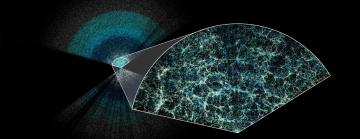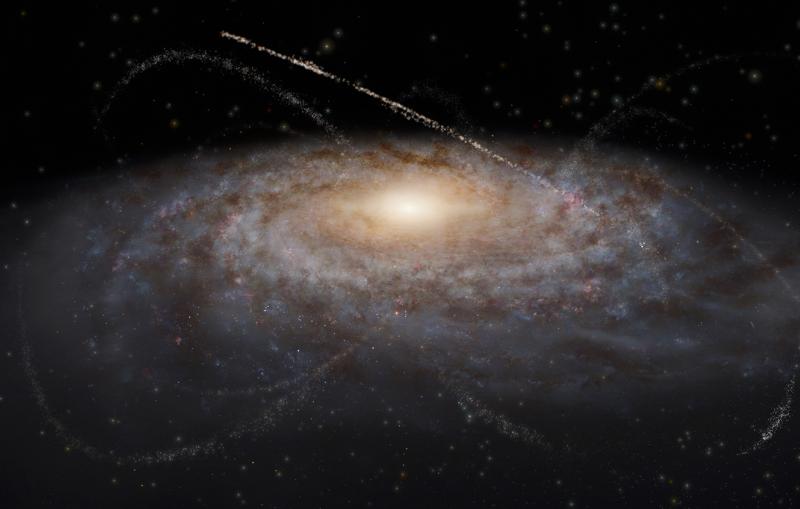First results from DESI make the most precise measurement of our expanding universe
Researchers have used the Dark Energy Spectroscopic Instrument to make the largest 3D map of our universe and world-leading measurements of dark energy, the mysterious force behind its accelerating expansion.
Understanding how our universe has evolved is tied to one of the biggest mysteries in physics: dark energy, the unknown ingredient causing our universe to expand faster and faster.
To study dark energy’s effects over the past 11 billion years, DESI has created the largest 3D map of our cosmos ever constructed, with the most precise measurements to date. This is the first time scientists have measured the expansion history of the young universe with a precision better than 1%, giving us our best view yet of how the universe evolved. Researchers shared the analysis of their first year of collected data in multiple papers posted today on the arXiv and in talks at the American Physical Society meeting in the United States and the Rencontres de Moriond in Italy.
“We’re incredibly proud of the data, which have produced world-leading cosmology results and are the first to come out of new generation of dark energy experiments,” said Michael Levi, DESI director and a scientist at the Department of Energy’s Lawrence Berkeley National Laboratory (Berkeley Lab), which manages the project. “So far, we’re seeing basic agreement with our best model of the universe, but we’re also seeing some potentially interesting differences that could indicate that dark energy is evolving with time. Those may or may not go away with more data, so we’re excited to start analyzing our three-year dataset soon.”
DESI is an international collaboration that analyzes the spectra, or colors, of light from galaxies and extremely distant objects called quasars – giant black holes that give off bright light as material spirals into their. By the end of the survey, DESI plans to map 3 million quasars and 37 million galaxies.
“No spectroscopic experiment has had this much data before, and we’re continuing to gather data from more than a million galaxies every month,” said Nathalie Palanque-Delabrouille, a Berkeley Lab scientist and co-spokesperson for the experiment. “It’s astonishing that with only our first year of data, we can already measure the expansion history of our universe at seven different slices of cosmic time, each with a precision of 1 to 3%. The team put in a tremendous amount of work to account for instrumental and theoretical modeling intricacies, which gives us confidence in the robustness of our first results.”
Researchers at DOE's SLAC National Accelerator Laboratory played a key role in building sophisticated survey simulations that were used to test the various techniques that went into DESI's first round of results, said Sandy Yuan, a postdoctoral fellow at the Kavli Institute for Particle Astrophysics and Cosmology.
"I am excited about DESI shedding light on important open questions in cosmology," Yuan said, such as tensions between different measurements of the Hubble constant, which expresses how fast the universe is expanding. "The accuracy and purity of DESI data will cast a strong vote in these tensions, and DESI will also push hard on questions regarding the primordial universe, neutrinos, and dark energy."
Emmanuel Schaan, a staff scientist at SLAC who works on DESI and the Atacama Cosmology Telescope (ACT), said that he is looking forward to collaborations made possible by the amount of data coming in and the large area of the sky DESI covers. "DESI and ACT both observe large parts of the sky, resulting in a large overlap. We can therefore look for correlations between the galaxy catalogs of DESI and the microwave maps of ACT," Schaan said. "These correlations reveal a wealth of new information that wouldn't be seen in either DESI or ACT alone: the whole is greater than the sum of its parts."
DESI’s data will similarly be used to complement future sky surveys such as the Vera C. Rubin Observatory and Nancy Grace Roman Space Telescope, and to prepare for a potential upgrade to DESI (DESI-II) that was recommended in a recent report by the U.S. Particle Physics Project Prioritization Panel.
"I am very excited to see the most precise measurements of spectroscopic galaxy clustering ever made, and what they tell us about cosmology," Schaan said "In particular, as hints of mild tensions have emerged between different cosmological observables, the DESI first-year measurements will be helpful in assessing consistency of different cosmological methods.
Beyond the cosmological parameter measurements, the unprecedentedly large galaxy catalogs themselves will be extremely valuable to the whole astrophysics community."
DESI is supported by the DOE Office of Science and by the National Energy Research Scientific Computing Center, a DOE Office of Science user facility. Additional support for DESI is provided by the U.S. National Science Foundation, the Science and Technology Facilities Council of the United Kingdom, the Gordon and Betty Moore Foundation, the Heising-Simons Foundation, the French Alternative Energies and Atomic Energy Commission (CEA), the National Council of Science and Technology of Mexico, the Ministry of Science and Innovation of Spain, and by the DESI member institutions.
The DESI collaboration is honored to be permitted to conduct scientific research on Iolkam Du’ag (Kitt Peak), a mountain with particular significance to the Tohono O’odham Nation.
This article is based on a press release from Berkeley Lab.
Contact
For questions or comments, contact the SLAC Office of Communications at communications@slac.stanford.edu.
About SLAC
SLAC National Accelerator Laboratory explores how the universe works at the biggest, smallest and fastest scales and invents powerful tools used by researchers around the globe. As world leaders in ultrafast science and bold explorers of the physics of the universe, we forge new ground in understanding our origins and building a healthier and more sustainable future. Our discovery and innovation help develop new materials and chemical processes and open unprecedented views of the cosmos and life’s most delicate machinery. Building on more than 60 years of visionary research, we help shape the future by advancing areas such as quantum technology, scientific computing and the development of next-generation accelerators.
SLAC is operated by Stanford University for the U.S. Department of Energy’s Office of Science. The Office of Science is the single largest supporter of basic research in the physical sciences in the United States and is working to address some of the most pressing challenges of our time.






